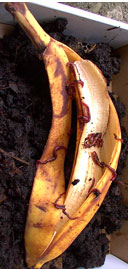 earth.worm.info
earth.worm.info
- Kitchen composting with redworms is a fun
and environmentally friendly alternative to taking out the garbage!
- Nightcrawlers can help your garden by mixing organic materials into the dirt
and aerating the soil.
~ Did you know?
- Composting in a worm bin is known as vermicomposing.
- Vermiculture is the art of raising worms.
- Worms reproduce sexually, but they have only one gender,
and can all produce both sperm and eggs.
The sexual organs of adults are in their bands.
- There are more than 3000 known specifies of earthworm.
That doesn't even count more
primitive worms such as the various types of
roundworm and
flatworm, let alone
the wormy larvae of completely unrelated creatures such as butterflies.
~ Keep worms inside your own home! Yes, really!
 Imagine a magic box into which you can place your garbage, where it won't smell bad
and where you can keep adding to it for months or years without it filling up.
That's a worm bin. No, the worms won't escape. No, they don't need dirt, just shredded newspaper;
redworms are a kind of worm that naturally lives in organic material.
Imagine a magic box into which you can place your garbage, where it won't smell bad
and where you can keep adding to it for months or years without it filling up.
That's a worm bin. No, the worms won't escape. No, they don't need dirt, just shredded newspaper;
redworms are a kind of worm that naturally lives in organic material.
You can get step-by-step instructions in building your own worm bin in the informative and fun book
Worms Eat My Garbage. It will tell you how to build your own worm bin and where to find worms,
if you want to do it all yourself and save money. Or, you can order both a durable plastic worm bin and a
box of worms online. Mine have lasted nine years (both the bin and the worm population.)

~ Where to buy worms and bins:
Check the Open Directory categories below for more information and for suppliers.
- Science: Agriculture: Animals: Invertebrates: Worm Farming
- Science: Biology: Flora and Fauna: Animalia: Annelida: Oligochaeta
-
For kids,
the
Worm Acres Composting Kit
looks like a good starter kit.

~ My own observations:
- Why do earthworms crawl onto the sidewalk when it rains?
Most people think it's to keep from drowning.
There are two problems with this theory: (1) Worms don't have
lungs for the water to get into; they breathe through their skins,
and can absorb oxygen from fresh water just as easily as from fresh air.
(2a) Worms were around for millions of years before sidewalks were
invented, and somehow managed to get by. (2b) What do worms do
in open space and in rural areas that have no sidewalks? Pile up
onto the nearest rock whenever it rains? My theory is that
they cross sidewalks and roads when they're wet because that's
the only time they can. They can't tunnel underneath
because the dirt is compacted and doused with oil for half a meter
underneath; below that, no oxygen gets through. In terms of passing
on its genes, a worm that has had hundreds of children already has
a real advantage in risking a crossing. If it dies trying to find a new
world to colonize on the other side, its children will live on.
If it happens to reach some organically rich dirt where no worm has
gone before, then a few years later it will have thousands of descendants.
It helps that each worm can produce both sperm and eggs. If it doesn't
find a partner and isn't already carrying eggs, it can always fertilize
itself.
- How to get rid of gnats in a worm bin:
The author of Worms Eat My Garbage (see above) is right.
Fruit flies, or in my case their cousins
fungus gnats, are the
most annoying thing about worm bins. Not odors or mess or any
other problems people expect when they haven't tried it.
I found that the simplest thing that helps control them is soap.
Soaping any airhole opening on the inside of the lid that they might
crawl through seems to help, and the easiest way to get rid of
them when that fails is to pick up mating pairs by touching them
with soapy fingers. But the only thing that eradicated them
entirely, in my experience, was mixing gnat-specific Bt into
the bedding. The brand name is Gnatrol, and you can
order it online from GHA Organics
if you ever experience the problem.
Brought to you by Songworm.com
 earth.worm.info
earth.worm.info
 earth.worm.info
earth.worm.info
 Imagine a magic box into which you can place your garbage, where it won't smell bad
and where you can keep adding to it for months or years without it filling up.
That's a worm bin. No, the worms won't escape. No, they don't need dirt, just shredded newspaper;
redworms are a kind of worm that naturally lives in organic material.
Imagine a magic box into which you can place your garbage, where it won't smell bad
and where you can keep adding to it for months or years without it filling up.
That's a worm bin. No, the worms won't escape. No, they don't need dirt, just shredded newspaper;
redworms are a kind of worm that naturally lives in organic material.

